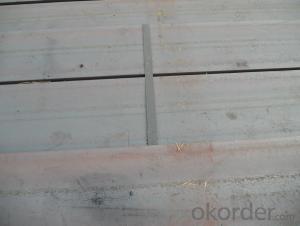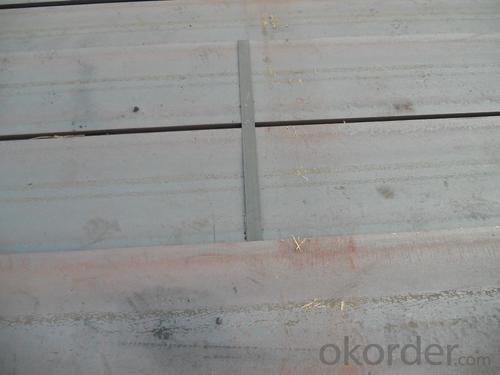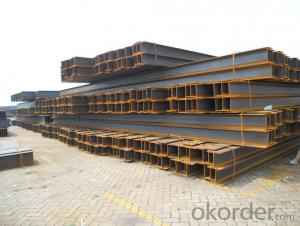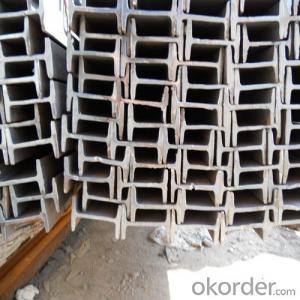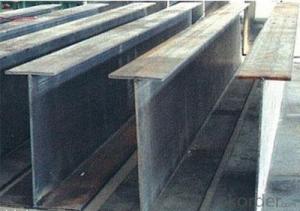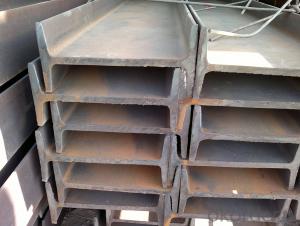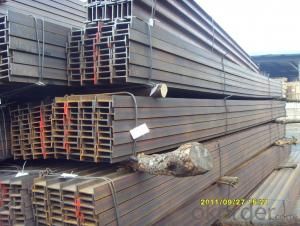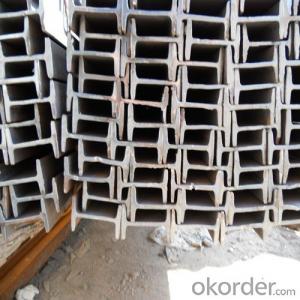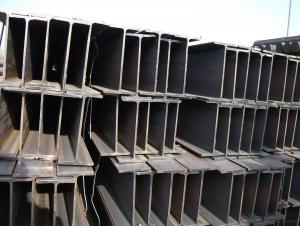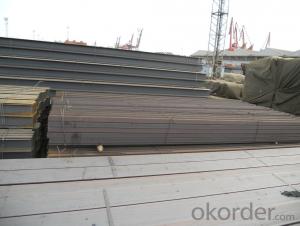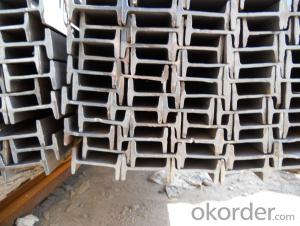Hot rolled H beams/Ibeams GB standard/JIS standard
- Loading Port:
- Tianjin
- Payment Terms:
- TT OR LC
- Min Order Qty:
- 50 m.t.
- Supply Capability:
- 2500 m.t./month
OKorder Service Pledge
OKorder Financial Service
You Might Also Like
Packaging & Delivery
Packaging Detail: packed in bundle, suitable for sea transport (by container) or According to the clients`requirements
Delivery Detail: According to the actual weight
Specifications
joist steel
high quality and factory price
large inventories
short delievery time
good after-sales service
Country of Origin: China
Mill name: Ningbo Preah Vihear Steel Industry Co., Ltd.
Commodity: H beam
Tolerance: Strictly according to the G/B and JIS standard
Delivery time: within 30days
Price term: CIF/ CFR according to clients requirements
Payment terms: 100%Irrevercable L/C At Sight or TT
Product Description
ACCORDING TO STANDARD: JIS G3192 OR GB/T11263-2005
H beam Section sizenma(mm) Weight (kg/m)
Height×Breadth Web thichness Flange thichness
100×100 6 8 16.9
125×125 6.5 9 23.6
150×150 7 10 31.1
175×175 7.5 11 40.4
200×200 8 12 49.9
250×250 9 14 71.8
300×300 10 15 93.0
300×300 15 15 105.0
350×350 12 19 134.9
400×400 13 21 171.7
148×100 6 9 20.7
194×150 6 9 29.9
244×175 7 11 43.6
294×200 8 12 55.8
340×250 9 14 78.1
390×300 10 16 104.6
440×300 11 18 120.8
482×300 11 15 110.8
488×300 11 18 124.9
582×300 12 17 132.8
588×300 12 20 147.0
100×50 5 7 9.3
125×60 6 8 13.1
150×75 5 7 14.0
175×90 5 8 18.0
198×99 4.5 7 17.8
200×100 5.5 8 20.9
248×124 5 8 25.1
250×125 6 9 29.0
298×149 5.5 8 32.0
300×150 6.5 9 36.7
346×174 6 9 41.2
350×175 7 11 49.4
396×199 7 11 56.1
400×200 8 13 65.4
446×199 8 12 65.1
450×200 9 14 74.9
496×199 9 14 77.9
500×200 10 16 88.1
596×199 10 15 92.4
600×200 11 17 103.4
700×300 13 24 181.8
800×300 14 26 206.8
900×300 16 28 240.1
- Q: Can steel H-beams be used in telecommunications towers?
- Yes, steel H-beams can be used in telecommunications towers. Steel H-beams are commonly used in construction due to their strength and durability. They provide excellent structural support and can withstand heavy loads and extreme weather conditions, making them suitable for telecommunications towers. These towers require a strong and stable structure to support the antennas and other equipment. Steel H-beams offer the necessary strength and stability, making them a popular choice in the construction of telecommunications towers.
- Q: How do Steel H-Beams compare in terms of lifespan and durability?
- Steel H-Beams are known for their exceptional lifespan and durability. These structural members are specifically designed to withstand heavy loads and provide long-lasting support for various construction projects. The lifespan of steel H-Beams can be significantly longer compared to other building materials such as wood or concrete. One of the key factors contributing to their durability is the inherent strength of steel. H-Beams are made from high-quality steel, which has superior tensile strength and resistance to bending and twisting forces. This enables them to withstand extreme weather conditions, seismic activity, and other external factors that can cause damage to structures over time. Moreover, steel H-Beams are not susceptible to rot, decay, or insect infestations like wooden beams. They also do not degrade or weaken under moisture, which is a common issue with concrete structures. This makes steel H-Beams highly durable and reliable, ensuring their long-term performance and structural integrity. Additionally, steel H-Beams are resistant to fire, which further enhances their lifespan and durability. Steel has a high melting point and does not contribute fuel to a fire, making it a safer choice for structural elements. This characteristic is particularly important in high-rise buildings or structures where fire protection is a critical consideration. Furthermore, steel H-Beams can be easily inspected for any signs of wear or damage. Regular maintenance and inspections can help identify and address any issues promptly, ensuring the continued durability and longevity of these structural members. In conclusion, steel H-Beams have a remarkable lifespan and durability due to their high strength, resistance to environmental factors, and fire resistance. These qualities make them an excellent choice for a wide range of construction projects where longevity and structural integrity are paramount.
- Q: Can steel H-beams be used for overhead crane support?
- Yes, steel H-beams can be used for overhead crane support. H-beams are commonly used in the construction industry for their strength and durability. Their shape provides excellent load-bearing capabilities, making them suitable for supporting heavy loads, such as those carried by overhead cranes. Additionally, H-beams are available in various sizes and can be easily welded or bolted together to create the desired support structure for an overhead crane. However, it is important to consider the specific requirements of the crane system and consult with a structural engineer or crane manufacturer to ensure that the H-beams are properly designed and installed to meet the necessary safety and load-bearing standards.
- Q: How do steel H-beams perform in heavy snow loads?
- Steel H-beams perform exceptionally well in heavy snow loads due to their structural strength and durability. The H-shape design of the beam provides excellent load-bearing capabilities, allowing it to withstand the weight of accumulated snow without deformation or failure. Additionally, steel is known for its resistance to extreme weather conditions, including snow and ice, making H-beams a reliable choice for structures in snowy areas.
- Q: How are steel H-beams manufactured?
- Hot rolling is the process used to manufacture steel H-beams. It begins with the selection of high-quality steel, usually in the form of a large billet. This billet is then heated to a temperature above its recrystallization point, typically around 1200 to 1300 degrees Celsius. Once the billet reaches the desired temperature, it is fed into a rolling mill. The mill consists of a series of rollers that gradually shape the heated billet into the H-beam profile. The rollers apply pressure to the billet, causing it to elongate and take on the desired shape. This is known as hot rolling because the steel is rolled while it is still hot and malleable. Throughout the rolling process, the billet is continuously passed through the rollers, undergoing multiple passes until it achieves the required dimensions and shape. The final profile of the H-beam is determined by the shape of the rollers, with each roller gradually shaping the steel. Once the rolling process is completed, the newly formed H-beams are cooled using either air or water. This cooling process is crucial to maintaining the steel's strength and structural integrity. After cooling, the H-beams are cut to the desired lengths and undergo any necessary further processing, such as surface treatment or galvanization. Finally, they are packaged and shipped to customers. In summary, the manufacturing of steel H-beams involves heating a billet to a high temperature, rolling it through a series of rollers to shape it, cooling it, and then further processing it. This process ensures the production of high-quality and structurally sound H-beams that are used in construction and engineering projects.
- Q: Can steel H-beams be used in retrofitting or renovation projects?
- Indeed, retrofitting or renovation projects can indeed make use of steel H-beams. Owing to their strength and versatility, steel H-beams are widely employed in construction. They can serve to fortify existing structures, offer supplementary support, or even establish a fresh framework for renovations. Frequently, steel H-beams are employed in endeavors where the ability to bear heavy loads is indispensable, such as the addition of extra floors or the expansion of preexisting structures. Moreover, in seismic retrofitting projects, steel H-beams prove advantageous as they aid in the distribution of forces arising from earthquakes. All in all, steel H-beams present themselves as a dependable and efficient solution for retrofitting or renovation projects.
- Q: What are the different installation methods for steel H-beams?
- There are several different installation methods for steel H-beams, depending on the specific application and structural requirements. Some of the commonly used methods include: 1. Welding: This is one of the most common methods for installing steel H-beams. It involves welding the beam to the supporting structure or connecting it to other beams or columns using welding techniques. Welding provides a strong and durable connection, but it requires skilled labor and proper welding procedures to ensure structural integrity. 2. Bolting: Another popular method is bolting, where the H-beam is connected to the supporting structure or other beams using bolts and nuts. This method offers flexibility as it allows for easy disassembly and reassembly, making it suitable for temporary structures or situations where modifications may be required. It is important to ensure proper bolt size, torque, and alignment to maintain structural stability. 3. Grouting: In some cases, H-beams may be embedded in concrete structures for added strength and stability. Grouting involves filling the space between the beam and the concrete with a high-strength, non-shrink grout to create a solid connection. This method is commonly used in construction projects where high load-bearing capacity is required. 4. Crane or hoist installation: In situations where the H-beam is too heavy or large to be installed manually, a crane or hoist can be used. This method involves lifting the beam into position and securing it using welding or bolting techniques as described above. It is important to adhere to proper lifting and rigging procedures to ensure safety and avoid any damage to the beam or surrounding structures. 5. Pre-engineered systems: Some manufacturers offer pre-engineered systems for steel H-beam installation. These systems typically include pre-cut and pre-drilled beams, along with detailed assembly instructions. This method simplifies the installation process and ensures accurate alignment and connection of the beams. It is important to consult with a structural engineer or construction professional to determine the most suitable installation method for steel H-beams based on the specific project requirements and local building codes.
- Q: What are the design considerations for steel H-beams in earthquake-prone regions?
- The design considerations for steel H-beams in earthquake-prone regions primarily involve ensuring structural integrity and resilience. Some key considerations include selecting appropriate steel grades with high ductility and strength, designing for lateral loads and dynamic forces, incorporating proper bracing and connections to enhance stability, accounting for potential ground motion, and implementing effective seismic detailing to resist earthquake forces. Additionally, the design should consider local building codes and regulations specific to earthquake-prone regions to ensure compliance and enhance the overall safety of the structure.
- Q: What are the differences between hot-rolled and cold-formed steel H-beams?
- Hot-rolled and cold-formed H-beams are two structural steel products commonly used in construction. Their manufacturing processes and properties differ significantly. To begin with, hot-rolled H-beams are made by heating a steel billet or slab above its recrystallization temperature, followed by shaping it using rollers. This results in a rough surface texture and a scaled outer layer. In contrast, cold-formed H-beams are created by bending and shaping steel sheets or strips at room temperature, often using rollers or press brakes. This method produces a smoother surface finish and eliminates the need for scaling. Regarding their properties, hot-rolled H-beams generally have higher strength and load-bearing capacity compared to cold-formed H-beams. This is due to the structural changes that occur during the hot-rolling process, which refine the grain structure of the steel and enhance its overall toughness. On the other hand, cold-formed H-beams exhibit greater dimensional accuracy and consistency, thanks to the precise shaping and bending process. This makes them suitable for applications that require precise measurements and tight tolerances. Another notable difference lies in their cost and availability. Hot-rolled H-beams are generally more readily available and cost-effective compared to cold-formed H-beams. The hot-rolling process is faster and more efficient, allowing for larger production volumes and lower production costs. In contrast, cold-formed H-beams may require additional processing and fabrication steps, which can increase their overall cost. In summary, hot-rolled and cold-formed H-beams differ in terms of their manufacturing processes, surface finish, properties, and cost. Hot-rolled H-beams offer higher strength and load-bearing capacity, while cold-formed H-beams provide greater dimensional accuracy and consistency. The choice between the two depends on specific project requirements, such as budget, structural needs, and aesthetic considerations.
- Q: Are steel H-beams resistant to ultraviolet (UV) radiation?
- Steel H-beams do not possess inherent resistance to ultraviolet (UV) radiation. Over time, UV radiation from the sun can lead to degradation and discoloration of steel surfaces. However, the extent of this degradation depends on factors such as the specific type of steel used, as well as the duration and intensity of UV exposure. To counteract the effects of UV radiation on steel H-beams, one can apply protective coatings. These coatings serve as a barrier, safeguarding the steel from direct UV ray exposure. Common protective coatings for steel include paint, powder coating, and galvanizing. Paint coatings offer a layer of protection against UV radiation, but they may require periodic maintenance and reapplication to maintain effectiveness. On the other hand, powder coating provides greater durability and UV resistance. Galvanizing is an alternative option, involving the application of a zinc layer to protect against UV radiation and corrosion. It is important to note that even with protective coatings, the long-term durability of steel H-beams under UV exposure depends on factors like coating quality, installation environment, and maintenance practices. Regular inspection and maintenance can help identify signs of degradation or damage, allowing for timely repairs or reapplication of protective coatings if necessary. In conclusion, while steel H-beams lack inherent resistance to UV radiation, the use of protective coatings can significantly enhance their ability to withstand UV degradation and prolong their lifespan.
Send your message to us
Hot rolled H beams/Ibeams GB standard/JIS standard
- Loading Port:
- Tianjin
- Payment Terms:
- TT OR LC
- Min Order Qty:
- 50 m.t.
- Supply Capability:
- 2500 m.t./month
OKorder Service Pledge
OKorder Financial Service
Similar products
Hot products
Hot Searches
Related keywords
